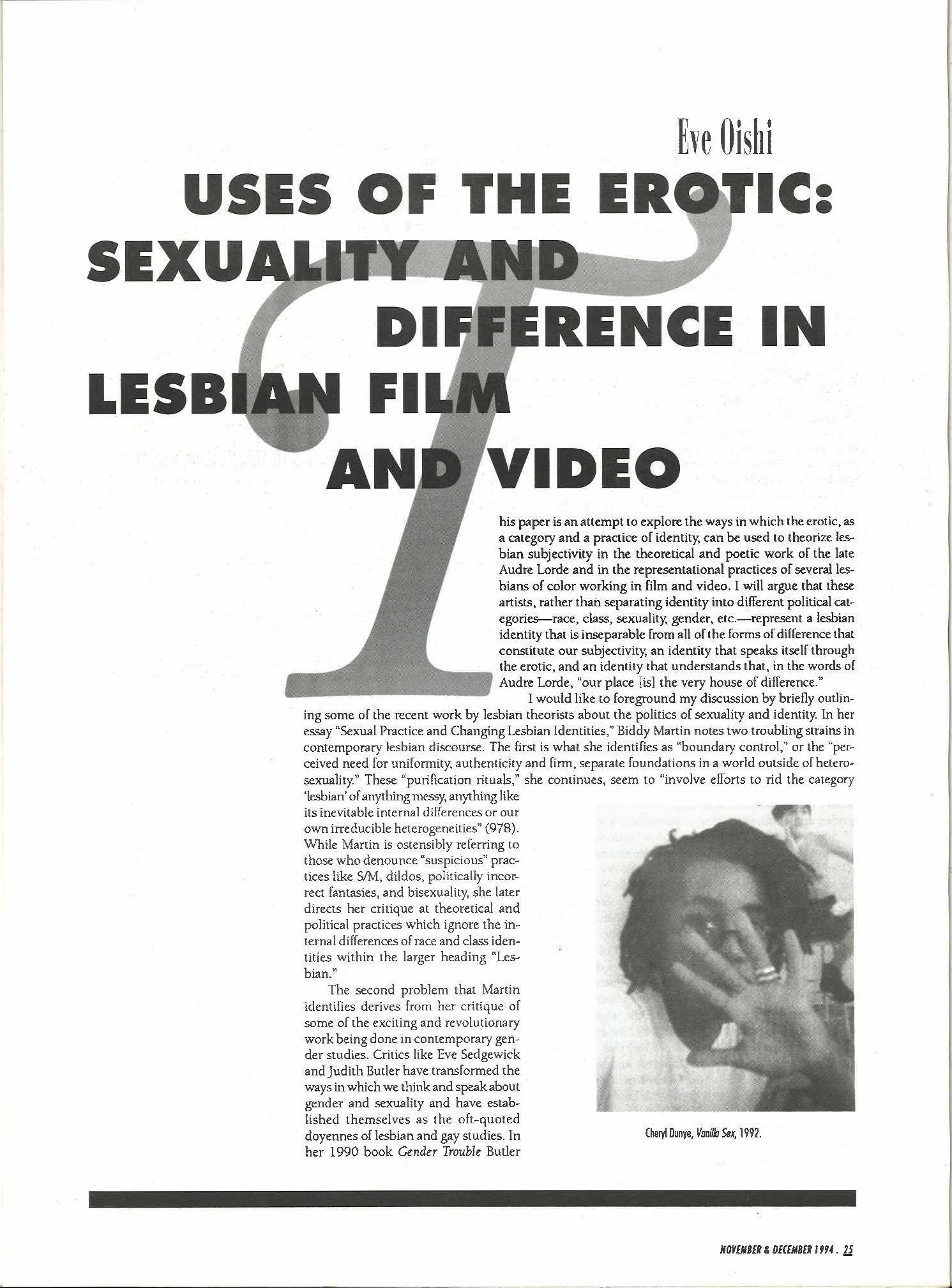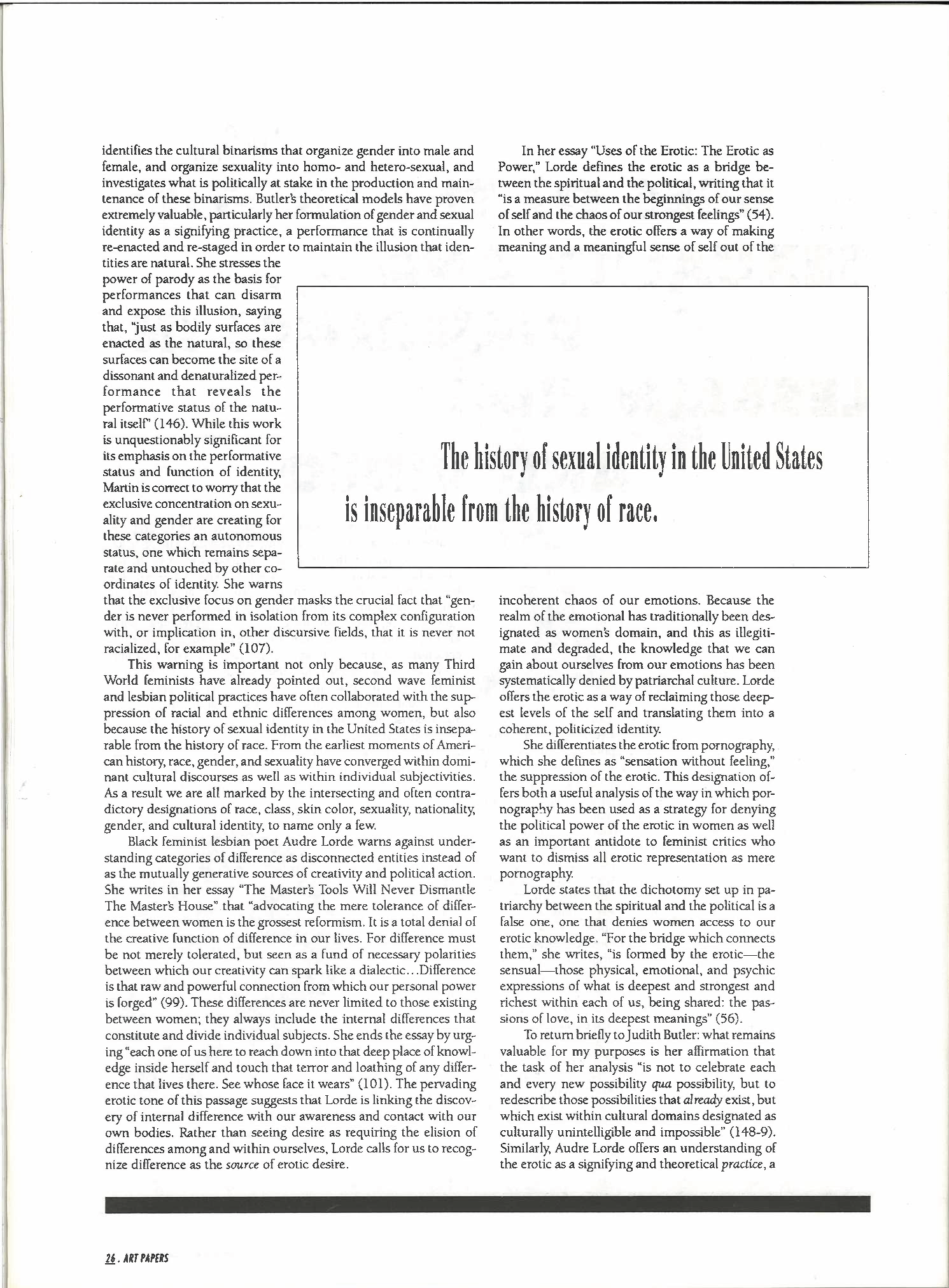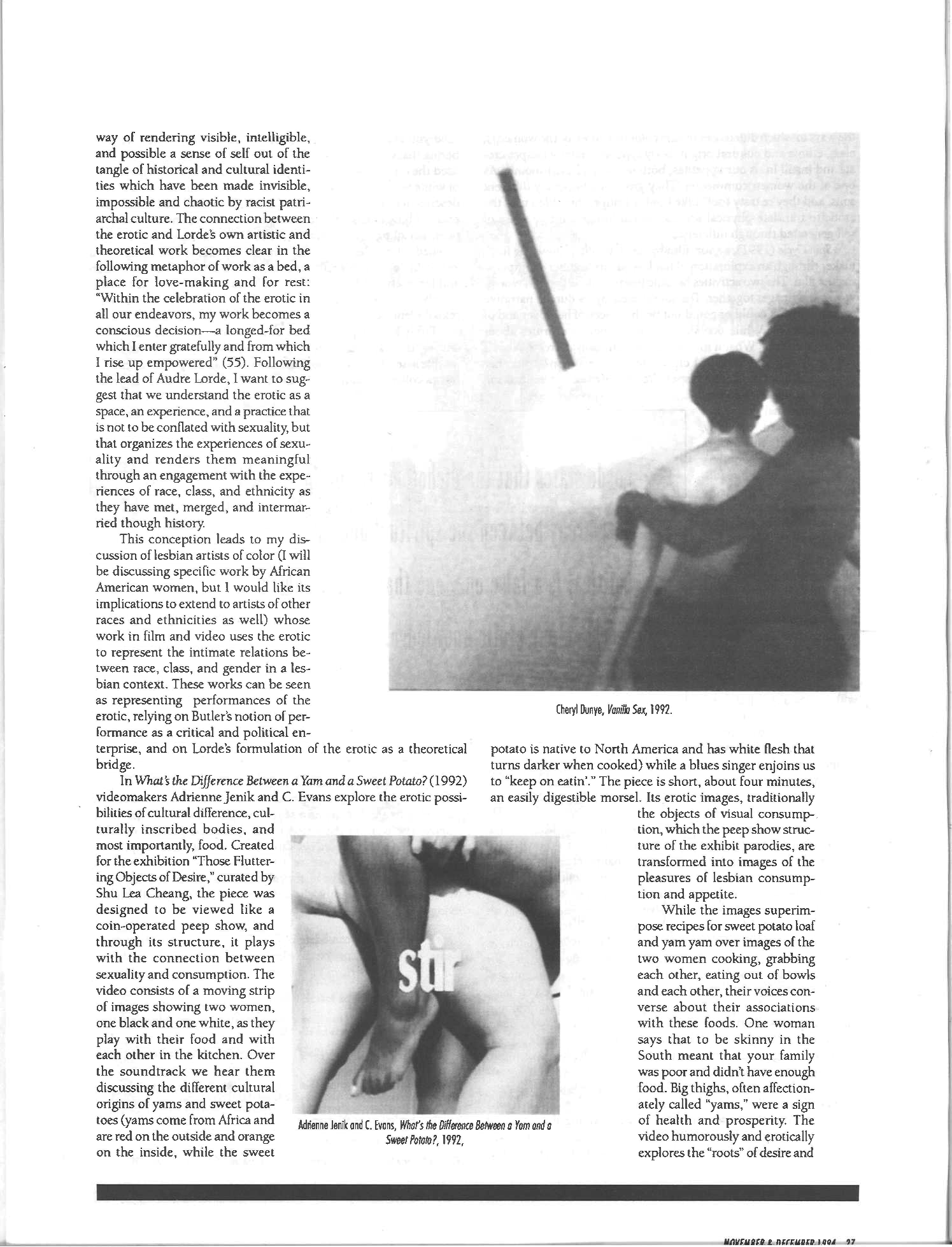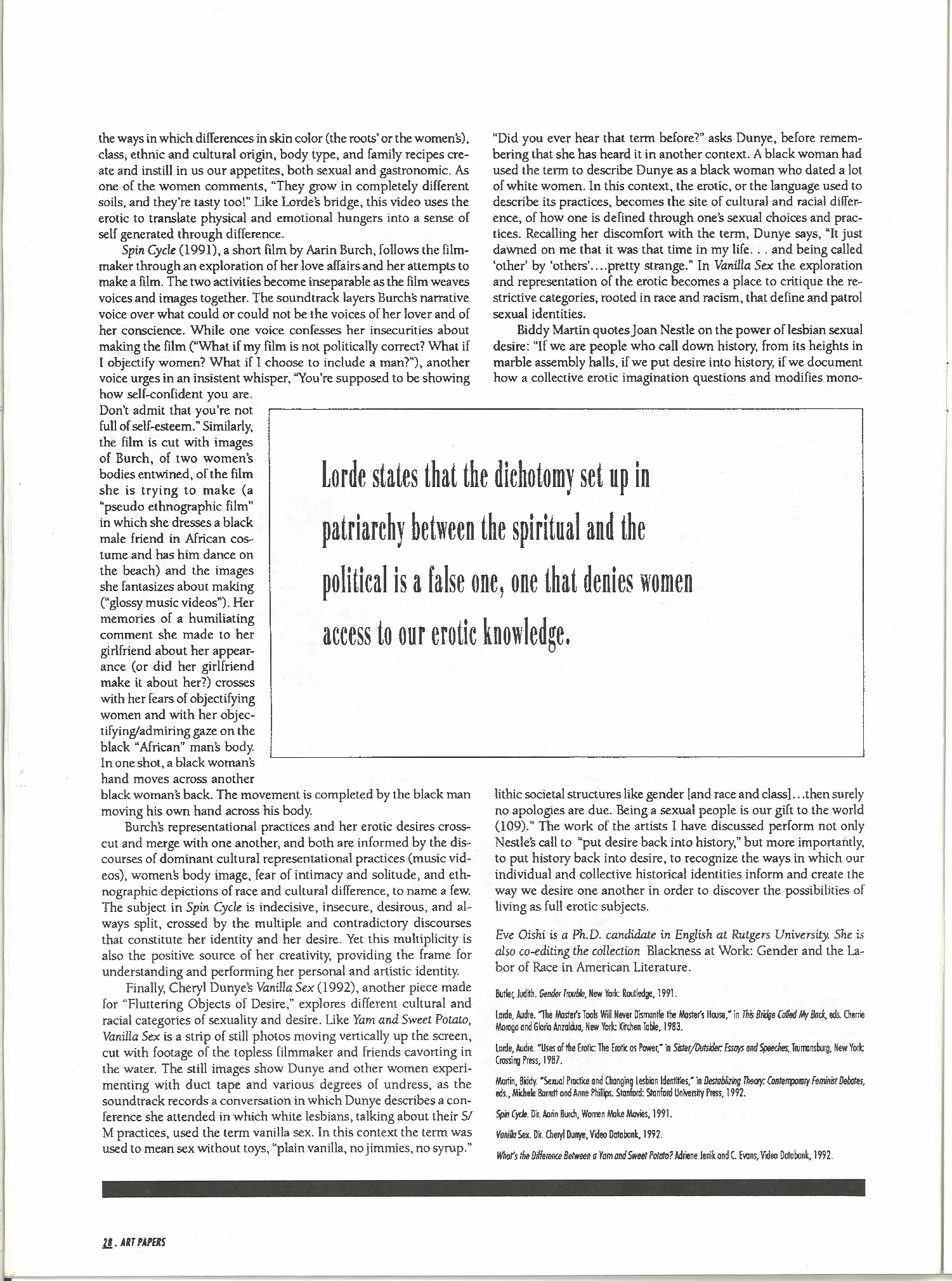Uses of the Erotic: Sexuality and Difference in Lesbian Film and Video
Share:
This paper is an attempt to explore the ways in which the erotic, as a category and a practice of identity, can be used to theorize lesbian subjectivity in the theoretical and poetic work of the late Audre Lorde and in the representational practices of several lesbians of color working in film and video. I will argue that these artists, rather than separating identity into different political categories – race, class, sexuality, gender, etc. – represent a lesbian identity that is inseparable from all of the forms of difference that constitute our subjectivity, an identity that speaks itself through the erotic, and an identity that understands that, in the words of Audre Lorde, “our place [is] the very house of difference.”
I would like to foreground my discussion by briefly outlining some of the recent work by lesbian theorists about the politics of sexuality and identity. In her essay “Sexual Practice and Changing Lesbian Identities,” Biddy Martin notes two troubling strains in contemporary lesbian discourse. The first is what she identifies as “boundary control,” or the “perceived need for uniformity, authenticity and firm, separate foundations in a world outside of heterosexuality.” These “purification rituals,” she continues, seem to “involve efforts to rid the category ‘lesbian’ of anything messy, anything like its inevitable internal differences or our own irreducible heterogeneities”.1 While Martin is ostensibly referring to those who denounce “suspicious” practices like S/M, dildos, politically incorrect fantasies, and bisexuality, she later directs her critique at theoretical and political practices which ignore the internal differences of race and class identities within the larger heading “Lesbian.”
The second problem that Martin identifies derives from her critique of some of the exciting and revolutionary work being done in contemporary gender studies. Critics like Eve Sedgewick and Judith Butler have transformed the ways in which we think and speak about gender and sexuality and have established themselves as the oft-quoted doyennes of lesbian and gay studies. In her 1990 book Gender Trouble Butler identifies the cultural binarisms that organize gender into male and female, and organize sexuality into homo- and hetero-sexual, and investigates what is politically at stake in the production and maintenance of these binarisms. Butler’s theoretical models have proven extremely valuable, particularly her formation of gender and sexual identity as a signifying practice, a performance that is continually re-enacted and re-staged in order to maintain the illusion that identities are natural. She stresses the power of parody as the basis for performances that can disarm and expose this illusion, saying that, “just as bodily surfaces are enacted as the natural, so these surfaces can become the site of a dissonant and denaturalized performance that reveals the performative status of the natural itself” 2. While this work is unquestionably significant for its emphasis on the performative status and function of identity, Martin is correct to worry that the exclusive concentration on sexuality and gender are creating for these categories an autonomous status, one which remains separate and untouched by other coordinates of identity. She warns that the exclusive focus on gender masks the crucial fact that “gender is never performed in isolation from its complex configuration with, or implication in, other discursive fields, that it is never not racialized, for example”. 3
This warning is important not only because, as many Third World feminists have already pointed out, second wave feminist and lesbian political practices have often collaborated with the suppression of racial and ethnic differences among women, but also because the history of sexual identity in the United States is inseparable from the history of race. From the earliest moments of American history, race, gender, and sexuality have converged within dominant cultural discourses as well as within individual subjectivities. As a result we are all marked by the intersecting and often contradictory designations of race, class, skin color, sexuality, nationality, gender, and cultural identity, to name only a few.
Black feminist lesbian poet Audre Lorde warns against understanding categories of difference as disconnected entities instead of as the mutually generative sources of creativity and political action. She writes in her essay “The Master’s Tools Will Never Dismantle The Master’s House” that “advocating the mere tolerance of difference between women is the grossest reformism. It is a total denial of the creative function of difference in our lives. For difference must not be merely tolerated, but seen as a fund of necessary polarities between which our creativity can spark like a dialectic…Difference is that raw and powerful connection from which our personal power is forged”. 4 These differences are never limited to those existing between women; they always include the internal differences that constitute and divide individual subjects. She ends the essay by urging “each one of us here to reach down into that deep place of knowledge within herself and touch the terror and loathing of any difference that lives there. See whose face it wears”.5 The pervading erotic tone of this passage suggests that Lorde is linking the discovery of internal difference with our awareness and contact with our own bodies. Rather than seeing desire as requiring the elision of differences among and within ourselves, Lorde calls for us to recognize difference as the source of erotic desire.
In her essay “Uses of the Erotic: The Erotic as Power,” Lorde defines the erotic as a bridge between the spiritual and the political, writing that it “is a measure between the beginnings of our sense of self and the chaos of our strongest feelings”.6 In other words, the erotic offers a way of making meaning and a meaningful sense of self out of the incoherent chaos of our emotions. Because the realm of the emotional has traditionally been designated as women’s domain, and this is as illegitimate and degraded, the knowledge that we can gain about ourselves from our emotions has been systematically denied by patriarchal culture. Lorde offers the erotic as a way of reclaiming those deepest levels of the self and translating them into a coherent, politicized identity.
She differentiates the erotic from pornography, which she defines as “sensation without feeling,” the suppression of the erotic. This designation offers both a useful analysis of the way in which pornography has been used as a strategy for denying the political power of the erotic in women as well as an important antidote to feminist critics who want to dismiss all erotic representation as mere pornography.
Lorde states that the dichotomy set up in patriarchy between the spiritual and the political is a false one, one that denies women access to our erotic knowledge. “For the bridge which connects them,” she writes, “is formed by the erotic – the sensual – those physical, emotional, and psychic expressions of what is deepest and strongest and richest within each of us, being shared: the passions of love, in its deepest meanings”.7
To return briefly to Judith Butler: what remains valuable for my purposes is her affirmation that the task of her analysis “is not to celebrate each and every new possibility qua possibility, but to redescribe those possibilities that already exist, but which exist within cultural domains designated as culturally unintelligible and impossible”.8 Similarly, Audre Lorde offers an understanding of the erotic as a signifying and theoretical practice, a way of rendering visible, intelligible, and possible a sense of self out of the tangle of historical and cultural identities which have been made invisible, impossible, and chaotic by racist patriarchal culture. The connection between the erotic and Lorde’s own artistic and theoretical work becomes clear in a following metaphor of work as a bed, a place for love-making and for rest: “Within the celebration of the erotic in all our endeavors, my work becomes a conscious decision – a longed-for bed which I enter gratefully and from which I rise up empowered”.9 Following the lead of Audre Lorde, I want to suggest that we understand the erotic as a space, and experience, and a practice that is not to be conflated with sexuality, but that organizes the experiences of sexuality and renders them meaningful through an engagement with the experiences of race, class, and ethnicity as they have met, merged, and intermarried through history.
This conception leads to my discussion of lesbian artists of color (I will be discussing specific work by African American women, but I would like its implications to extend to artists of other races and ethnicities as well) whose work in film and video uses the erotic to represent the intimate relations between race, class, and gender in a lesbian context. These works can be seen as representing performances of the erotic, relying on Butler’s notion of performance as a critical and political enterprise, and on Lorde’s formulation of the erotic as a theoretical bridge.
In What’s the Difference Between a Yam and a Sweet Potato? (1992) videomakers Adrienne Jenik and C. Evans explore the erotic possibilities of cultural difference, culturally inscribed bodies, and most importantly, food. Created for the exhibition “Those Fluttering Objects of Desire,” curated by Shu Lea Cheang, the piece was designed to be viewed like a coin-operated peep show, and through its structure, it plays with the connection between sexuality and consumption. The video consists of a moving strip of images showing two women, one black and one white, as they place with their food and with each other in the kitchen. Over the soundtrack we hear them discussing the different cultural origins of yams and sweet potatoes (yams come from Africa and are red on the outside and orange on the inside, while the sweet potato is native to North America and has white flesh that turns darker when cooked) while a blues singer enjoins us to “keep on eatin’.” The piece is short, about four minutes, an easily digestible morsel. Its erotic images, traditionally the objects of visual consumption, which the peep show structure of the exhibit parodies, are transformed into images of the pleasures of lesbian consumption and appetite.
While the images superimpose recipes for sweet potato load and yam yam over images of the two women cooking, grabbing each other, eating out of bowls and each other, their voices converse about their associations with these foods. One woman says that to be skinny in the South meant that your family was poor and didn’t have enough food. Big thighs, often affectionately called “yams,” were a sign of health and prosperity. The video humorously and erotically explores the “roots” of desire and the ways in which differences in skin color (the roots’ or the women’s), class, ethnic and cultural origin, body type, and family recipes create and instill in us our appetites, both sexual and gastronomic. As one of the women comments, “They grow in completely different soils, and they’re tasty too!” Like Lorde’s bridge, this video uses the erotic to translate physical and emotional hungers into a sense of self generated through difference.
Spin Cycle (1991), a short film by Aarin Burch, follows the filmmaker through an exploration of her love affairs and her attempts to make a film. The two activities become inseparable as the film weaves voices and images together. The soundtrack layers Burch’s narrative voice over what could or could not be the voices of her lover and of her conscience. While one voice confesses her insecurities about making the film (“What if my film is not politically correct? What if I objectify women? What if I choose to include a man?”), another voice urges in an insistent whisper, “You’re supposed to be showing how self-confident you are. Don’t admit that you’re not full of self-esteem.”10 Similarly, the film is cut with images of Burch, of two women’s bodies entwined, of the film she is trying to make (a “pseudo ethnographic film” in which she dresses a black male friend in African costume and has him dance on the beach) and the images she fantasizes about making (“glossy music videos”). Her memories of a humiliating comment she made to her girlfriend about her appearance (or did her girlfriend make it about her?) crosses with her fears of objectifying women and with her objectifying/admiring gaze on the black “African” man’s body. In one shot, a black woman’s hand moves across another black woman’s back. The movement is completed by the black man moving his own hand across his body.
Burch’s representational practices and her erotic desires crosscut and merge with one another, and both are informed by the discourses of dominant cultural representational practices (music videos), women’s body image, fear of intimacy and solitude, and ethnographic depictions of race and cultural difference, to name a few. The subject in Spin Cycle is indecisive, insecure, desirous, and always split, crossed by the multiple and contradictory discourse that constitute her identity and her desire. Yet this multiplicity is also the positive source of her creativity, providing the frame for understanding and performing and personal and artistic identity.
Finally, Cheryl Dunye’s Vanilla Sex (1992), another piece made for “Fluttering Objects of Desire,” explores different cultural and racial categories of sexuality and desire. Like Yam and Sweet Potato, Vanilla Sex is a strip of still photos moving vertically up the screen, cut with footage of the topless filmmaker and friends cavorting in the water. The still images show Dunye and other women experimenting with duct tape and various degrees of undress, as the soundtrack records a conversation in which Dunye describes a conference she attended in which white lesbians, talking about their S/M practices, used the term vanilla sex. In this context the term was used to mean sex without toys, “plain vanilla, no jimmies, no syrup.” “Did you ever hear that term before?” asks Dunye, before remembering that she has heard it in another context. A black woman had used the term to describe Dunye as a black woman who dated a lot of white women. In this context, the erotic, or the language used to describe its practices, becomes the site of cultural and racial difference, of how one is defined through one’s sexual choices and practices. Recalling her discomfort with the term, Dunye says, “It just dawned on me that it was that time in my life … and being called ‘other’ by ‘others’ … pretty strange.”11 In Vanilla Sex the exploration and representation of the erotic becomes a place to critique the restrictive categories, rooted in race and racism, that define and patrol sexual identities.
Biddy Martin quotes Joan Nestle on the power of lesbian sexual desire: If we are people who call down history, from its heights in marble assembly halls, if we put desire into history, if we document how a collective erotic imagination questions and modifies monolithic societal structures like gender [and race and class] … then surely no apologies are due. Being a sexual people is our gift to the world ).12 ”The work of the artists I have discussed perform not only Nestle’s call to “put desire back into history,” but more importantly, to put history back into desire, to recognize the ways in which our individual and collective historical identities inform and create the way we desire one another in order to discover the possibilities of living as full erotic subjects.
Eve Oishi is a Ph.D. candidate in English at Rutgers University. She is also co-editing the collection Blackness at Work: Gender and the Labor of Race in American Literature.
References
| ↑1 | Martin, Biddy. “Sexual Practice and Changing Lesbian Identities,” in Destabilizing Theory: Contemporary Feminist Debates, eds., Michele Barrett and Anne Phillips. Stanford: Stanford University Press, 1992. |
|---|---|
| ↑2, ↑3 | Butler, Judith. Gender Trouble, New York: Routledge, 1991. |
| ↑4, ↑5 | Lourde, Audre. “The Master’s Tools Will Never Dismantle the Master’s House,” in This Bridge Called My Back, eds. Cherrie Moraga and Gloria Anzaldua, New York: Kitchen Table, 1983. |
| ↑6, ↑7 | Lorde, Audre. “Uses of the Erotic: The Erotic as Power,” in Sister/Outsider: Essays and Speeches, Trumansburg, New York: Crossing Press, 1987. |
| ↑8 | Butler, Judith. Gender Trouble, New York: Routledge, 1991. |
| ↑9 | Lorde, Audre. “Uses of the Erotic: The Erotic as Power,” in Sister/Outsider: Essays and Speeches, Trumansburg, New York: Crossing Press, 1987. |
| ↑10 | Spin Cycle. Dir. Aarin Burch, Women Make Movies, 199 |
| ↑11 | Vanilla Sex. Dir. Cheryl Dunye, Video Databank, 1992. What’s the Difference Between a Yam and a Sweet Potato? Adriene Jenik and C. Evans, Video Databank, 1992. |
| ↑12 | Martin, Biddy. “Sexual Practice and Changing Lesbian Identities,” in Destabilizing Theory: Contemporary Feminist Debates, eds., Michele Barrett and Anne Phillips. Stanford: Stanford University Press, 1992. |



